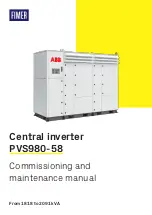
- -
37
Maintenance/Inspection
You should perform maintenance/inspection on a regular basis in order to ensure safety
and keep the inverter in good running order.
Precautions when performing maintenance/inspections
(1) The power should be turned on/off only by the person performing the task.
(2) The internal circuits of the inverter remain charged with high voltage for a short
while after power is turned off. To perform inspection, first turn off the power and
then wait for the LED display on the operation panel to go off (min. 15 minutes).
(3) Do not use a megger for the purpose of measuring insulation resistance.
Otherwise, the inverter is damaged.
Inspection items and environment
●
Ordinary/normal usage conditions
Ambient conditions: Annual mean temperature 30
°
C, max. 20 hrs/day at max. load rate 80%
●
Perform daily and periodic inspections in accordance with the following items:
Classification
Inspection cycle
Inspection items
Daily inspection
Daily
・
Ambient temperature, humidity, dirt, dust, foreign objects, etc.
・
Is there abnormal vibration/noise?
・
Is main circuit voltage normal?
・
Is there strange odor?
・
Is there lint in the air holes?
・
Cleanliness of control unit
・
Is wiring damaged?
・
Are equipment connections loose or off center?
・
Are foreign objects lodged in at the load side?
Periodic
inspections
1 year
・
Are fastened sections loose?
・
Is there evidence of overheating?
・
Are terminal blocks damaged?
<
Caution
>
Inspection cycle for periodic inspections may vary if usage conditions differ from those
given above.
Approximate period for part replacement
Period for part replacement varies depending on how the inverter is used. Parts must
be replaced or repaired when something is wrong with them.
Product
name
Part name
Standard
replacement period
(hrs)
Remarks
Smoothing capacitor
Approx. 5 years
Cooling fan
2 - 3 years (10 - 30
thousand hours)
Inverter
Aluminum electrolytic
capacitor on PCB
Approx. 5 years
Standard replacement period
gives a number of years for
reference only. If a part becomes
faulty it must be replaced even if
the standard replacement period
has not yet been reached.
















































